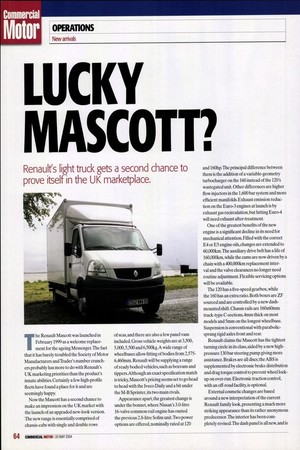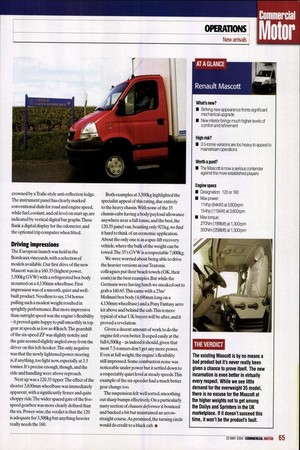LUCKY IVIASCOTT?
Page 62

Page 63

If you've noticed an error in this article please click here to report it so we can fix it.
Renault's light truck gets a second chance to
prove itself in the UK marketplace.
The Renault Mascott was launched in February 1999 as a welcome replacement for the ageing Messenger.The fact that it has barely troubled the Society of Motor Manufacturers and Trader's number crunchers probably has more to do with Renault's UK marketing priorities than the product's innate abilities. Certainly a few high-profile fleets have found a place for it and are seemingly happy. Now the Mascott has a second chance to make an impression on the UK market with the launch of an upgraded new-look version. The new range is essentially comprised of chassis-cabs with single and double rows
of seas, and there are also a few panel vans included. Gross vehicle weights are at 3,500, 5,000,5,500 and 6,500kg.A wide range of wheelbases allow fitting of bodies from 2,5756,460mm. Renault will be supplying a range of ready bodied vehicles, such as boxvans and tippers. Although an exact specification match is tricky,Mascott's pricing seems set to go head to head with the Iveco Daily and a bit under the M-B Sprinter, its two main rivals. Appearance apart, the greatest change is under the bonnet, where Nissan's 3.0-litre 16-valve common-rail engine has ousted the previous 2.8-litre Sofim unit.Two power options are offered, nominally rated at 120
and 160hp.The principal difference between them is the addition of a variable-geometry turbocharger on the 160 instead of the 120's wastegated unit. Other differences are higher flow injectors in the 1,600 bar system and more efficient manifolds. Exhaust emission reduction on the Euro-3 engines at launch is by exhaust gas recirculation, but hitting Euro-4 will need exhaust after-treatment.
One of the greatest benefits of the new engine is a significant decline in its need for mechanical attention. Filled with the correct E4 or E5 engine oils, changes are extended to 60,000km.The auxiliary drive belt has a life of 160,0001un, while the cams are now driven by a chain with a 400,000km replacement interval and the valve clearances no longer need routine adjustment. Flexible servicing options will be available.
The 120 has a five-speed gearbox, while the 160 has an extra ratio. Both boxes are ZF sourced and are controlled by a new dashmounted shift. Chassis rails are 160x6Onun truck-type C-sections,4nun thick on most models and 5mm on the longest wheelbase. Suspension is conventional with parabolicsprung rigid axles front and rear.
Renault claims the Mascott has the tightest turning circle in its class, aided by a new highpressure 130 bar steering pump giving more assistance. Brakes are all discs; the ABS is supplemented by electronic brake distribution and drag torque control to prevent wheel lockup on over-run. Electronic traction control, with an off-road facility, is optional. External cosmetic changes are based around a new interpretation of the current Renault family look, presenting a much more striking appearance than its rather anonymous predecessor.The interior has been completely revised.The dash panel is all new, and is
crowned by a Ikafic-style anti-reflection ledge. The instrument panel has clearly marked conventional dials for road and engine speed, while fuel, coolant, and oil level on start up, are indicated by vertical digital bar graphs.These flank a digital display for the odometer, and the optional trip computer when fitted. Driving impressions
The European launch was held in the Bordeaux vineyards, with a selection of models available. Our first drive of the new Mascott was in a 160.35 (highest power, 3,500kg GVVV) with a refrigerated box body mounted on a 4,130mm wheelbase. First impression was of a smooth, quiet and wellbuilt product. Needless to say, 154 horses pulling such a modest weight resulted in sprightly performance. But more impressive than outright speed was the engine's flexibility — it proved quite happy to pull smoothly in top gear at speeds as low as 40km/h.The gearshift of the six-speed ZF was slightly notchy and the gate seemed slightly angled away from the driver on this left-hooker.The only negative was that the newly lightened power steering is, if anything, too light now, especially at 35 tonnes. It's precise enough, though, and the ride and handling were above reproach.
Next up was a 120.35 tipper.The effect of the shorter 3,630nun wheelbase was immediately apparent, with a significantly firmer and quite choppy ride.The wider spaced gate of the fivespeed gearbox was more clearly defined than the six. Power-wise, the verdict is that the 120 is adequate for 3,500kg but anything heavier really needs the 160.
Both examples at 3,500kg highlighted the specialist appeal of this rating, due entirely to the heavy chassis. With none of the 35 chassis-cabs having a body/payload allowance anywhere near a full tonne, and the best, the 120.35 panel van, boasting only 921kg, we find it hard to think of an economic application. About the only one is as a spec-lift recovery vehicle, where the bulk of the weight can be towed.The 35's GVW is a respectable 7,000kg. We were worried about being able to drive the heavier versions as our Teutonic colleagues put their beach towels (OK, their coats) in the best examples. But while the Germans were having lunch we sneaked out to grab a 160.65.This came with a 25m3
Molinari box body (4,690mm long on a 4,130mm wheelbase) and a Pony Fantasy aero kit above and behind the cab.l'his is more typical of what UK buyers will be after, and it proved a revelation.
Given a decent amount of work to do the engine felt even better. It coped easily at the full 6,500kg — as indeed it should, given that most 7.5-tonners don't get any more power. Even at full weight, the engine's flexibility still impressed. Some combustion noise was noticeable under power but it settled down to a respectably quiet level at steady speeds.This example of the six-speeder had a much better gear change too. The suspension felt well sorted, smoothing out sharp bumps effectively. On a particularly nasty section of chausee deformee it bounced and bucked a bit but maintained an arrowstraight course. As promised, the turning circle would do credit to a black cab. •
What's new? • Striking new appearance fronts significant mechanical upgrade • New interior brings much higher levels of comfort and refinement
High risk? • 3.5-tonne versions are too heavy to appeal to mainstream operations
Worth a punt? • The Mascott is now a serious contender against the more established players Engine specs II Designation: 120 or 160 • Max power: 114hp (84kW) at 3,600rpm 154hp (115kW) at 3,600rpm • Max torque: 270Nm (199Ibft) at 1,300rpm 350Nm (258Ibft) at 1,300rpm




























































































































































































